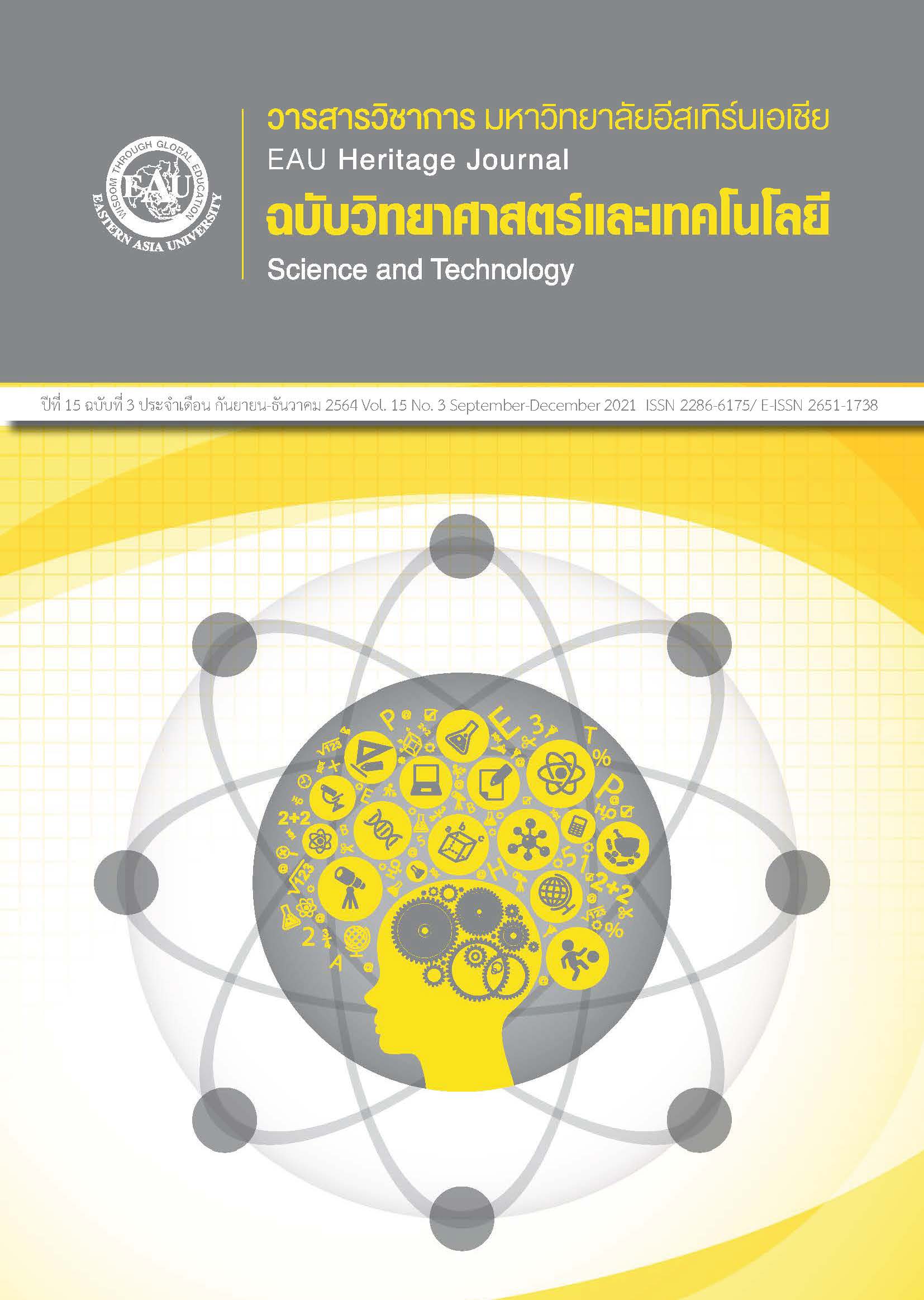การผลิตแผ่นไม้ปูพื้นจากต้นมันสำปะหลังโดยใช้ยางเครพเป็นกาวประสาน
คำสำคัญ:
แผ่นไม้ปูพื้น; ต้นมันสำปะหลัง; ยางเครพ; สมบัติเชิงกลบทคัดย่อ
งานวิจัยนี้มีวัตถุประสงค์เพื่อ ศึกษาถึงกระบวนการผลิตแผ่นไม้ปูพื้นจากต้นมันสำปะหลังโดยไม่ใช้สารเคมีเป็นตัวประสาน ศึกษาความเป็นไปได้ของการนำยางเครพมาเป็นตัวประสานในกระบวนการผลิตแผ่นไม้ปูพื้น และศึกษาคุณสมบัติการผลิตแผ่นไม้ปูพื้นจากต้นมันสำปะหลังโดยใช้ยางเครพเป็นตัวประสาน โดยใช้ยางเครพในปริมาณร้อยละ 0 5 10 และ 15 โดยน้ำหนักต่อผงต้นมันสำปะหลัง อัดขึ้นรูปด้วยวิธีการอัดแบบร้อนที่อุณหภูมิ 150 องศาเซลเซียส ด้วยแรงอัด 50 กิโลกรัมต่อตารางเซนติเมตร ระยะเวลา 10 นาที ได้แผ่นกระเบื้องยาง ขนาด 40x40x0.16 เซนติเมตร ทำการทดลองจำนวน 3 ซ้ำ การวิเคราะห์ข้อมูลค่าความแตกต่างทางสถิติโดยใช้ Analysis of Variance (ANOVA) และวิเคราะห์ความแตกต่างของค่าเฉลี่ย โดยใช้ Duncan’s New Multiple Range Test การทดสอบคุณสมบัติตามมาตรฐานผลิตภัณฑ์อุตสาหกรรม (มอก.876-2547) ผลการวิจัยพบว่า แผ่นไม้อัดจากต้นมันสำปะหลังโดยใช้ยางเครพเป็นกาวประสาน สามารถผลิตเป็นแผ่นชิ้นไม้อัดจากต้นมันสำปะหลัง โดยอัตราส่วนที่มีความเหมาะสมในการนำไปใช้ที่คุณสมบัติด้านความเเข็งแรงได้ดีที่อัตราส่วนผสมของยางเครพที่ 15% สามารถใช้ทดแทนเป็นไม้อัดความหนาแน่นปานกลางที่สามารถใช้เป็นวัสดุก่อสร้างตกแต่งภายในอาคาร และสามารถใช้เป็นแผ่นชิ้นไม้อัดชนิดอัดราบได้อีกทางเลือกหนึ่ง
เอกสารอ้างอิง
Ali, I., Jayaraman, K., & Bhattacharyya, D. (2014). Effects of resin and moisture content on the properties of medium density fibreboards made from kenaf bast fibres. Industrial Crops and Products, 52, 191-198. doi:10.1016/j.indcrop.2013.10.013
Desthalumpoo, T., & Wannaharnon, A. (2020). Appropriate ratio for using water hyacinth fibers for making cement fiberboard. Princess of Naradhiwas University Journal, 12(3), 262–276. (in Thai)
Homkraw, C., Bunchuaytan, W., & Cheewuthipong, W. (2016). Effect of palmyra fruit fiber and tapioca starch contents on properties of non-toxic fiberboard. Ladkrabang Engineering Journal, 33(3), 39-46. (in Thai)
Jangchad, I., Unhachok, T., Sarathamlee, P., & Unchittichai, W. (2002). Study of wood-polymer composite from hyacinth fibers and low-density polyethylene using polyethylene-graft-maliic anhydride for mixed. Annual Forestry Conference 2002 (p. 108). Bangkok: Department of Forestry. (in Thai).
Khempila, J., Namprai, C., & Kaewsai, A. (2019). Production of particleboard from lemongrass Leaves and rice straws. Pathumwan Academic Journal, 9(24), 1–15. (in Thai)
Klinphikul, N. (2014). A study of fiberboard sheets made of sawdust with the use of lac as adhesive (Research report). Bangkok: Rajamangala University of Technology Krungthep. (in Thai)
National Science and Technology Development Agency. (2020). Tapioca industry. Retrieved from http://www.nstda.or.th/industry/industry-casava. (in Thai)
Office of Agricultural Economics. (2019). Agricultural economic conditions in 2019. Retrieved from http://www.oae.go.th/view/1/TH-TH. (in Thai)
Paridah, M. T., Juliana, A. H., El-Shekeil, Y. A., Jawaid, M., & Alothman, O. Y. (2014). Measurement of mechanical and physical properties of particleboard by hybridization of kenaf with rubberwood particles. Measurement, 56, 70-80. https://doi.org/10.1016/j.measurement.2014.06.019.
Pholsuwan, A., Khamput, P., & Phuengphaingarm, B. (2005). Study of the properties of activated high density polyethylene with sawdust, rubber wood. The 10th national Convention on Civil Engineering. May 2-4, 2005 Ambassador City Hotel, Jomtien, Pattaya (pp. 39-43). Chonburi: MAT39-MAT43. (in Thai)
Prungsuk, S., Jarusombat, S., & Veenin, T. (2019). Effect of added boron compounds on physical, mechanical and fire retardant properties in particleboard. Thai Journal of Forestry, 38(1), 156-167. (in Thai)
Sukeetham, S., Jarusombat, S., & Veenin, T. (2019). Particleboard products from bamboo wastes of chopstick factory. Thai Journal of Forestry, 38(2), 192-201. (in Thai)
Thai Industrial Standard.TIS.876-2547. (2004, 5, August). Flat pressed particleboards. Ministry of Industry. Volume 121, Part 63, pp. 1-22. http://research.rid.go.th/vijais/moa/fulltext/TIS876-2547.pdf. (in Thai)
Wattanakitpaiboon, S., & Songthusrisakul, J. (2005). Study on the use of coconut clap fibers as reinforcement. Engineering Today, 3(34), 128-131. (in Thai)
Yotinwattanagumtorn, C. (2004). An investigation in to processability and properties of polypropylene/Wood Sawdust Composite (Master’s thesis). Mongkut's University of Technology Thonburi. Bangkok. (in Thai)
Yingprasert, W., & Suhansa, R. (2020). Properties of plywood produced with rubberwood veneer and Urea-formaldehyde Adhesive Added Borax. Thai Journal of Forestry (TJF), 39(1), 191-202. (in Thai)







